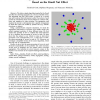Free Online Productivity Tools
i2Speak
i2Symbol
i2OCR
iTex2Img
iWeb2Print
iWeb2Shot
i2Type
iPdf2Split
iPdf2Merge
i2Bopomofo
i2Arabic
i2Style
i2Image
i2PDF
iLatex2Rtf
Sci2ools
94
Voted
IROS
2009
IEEE
2009
IEEE
Segregation in swarms of mobile robots based on the Brazil nut effect
— We study a simple algorithm inspired by the Brazil nut effect for achieving segregation in a swarm of mobile robots. The algorithm lets each robot mimic a particle of a certain size and broadcast this information locally. The motion of each particle is controlled by three reactive behaviors: random walk, taxis, and repulsion by other particles. The segregation task requires the swarm to self-organize into a spatial arrangement in which the robots are ranked by particle size (e.g., annular structures or stripes). Using a physics-based computer simulation, we study the segregation performance of swarms of 50 mobile robots. The robots represent particles of three different sizes. We first analyze the problem of how to combine the basic behaviors so as to minimize the percentage of errors in rank. We then show that the system is very robust to noise on inter-robot perception and communication. For a noise level of 50%, the mean percentage of errors in rank is 1%. Moreover, we investig...
| Added | 24 May 2010 |
| Updated | 24 May 2010 |
| Type | Conference |
| Year | 2009 |
| Where | IROS |
| Authors | Roderich Groß, Stéphane Magnenat, Francesco Mondada |
Comments (0)

